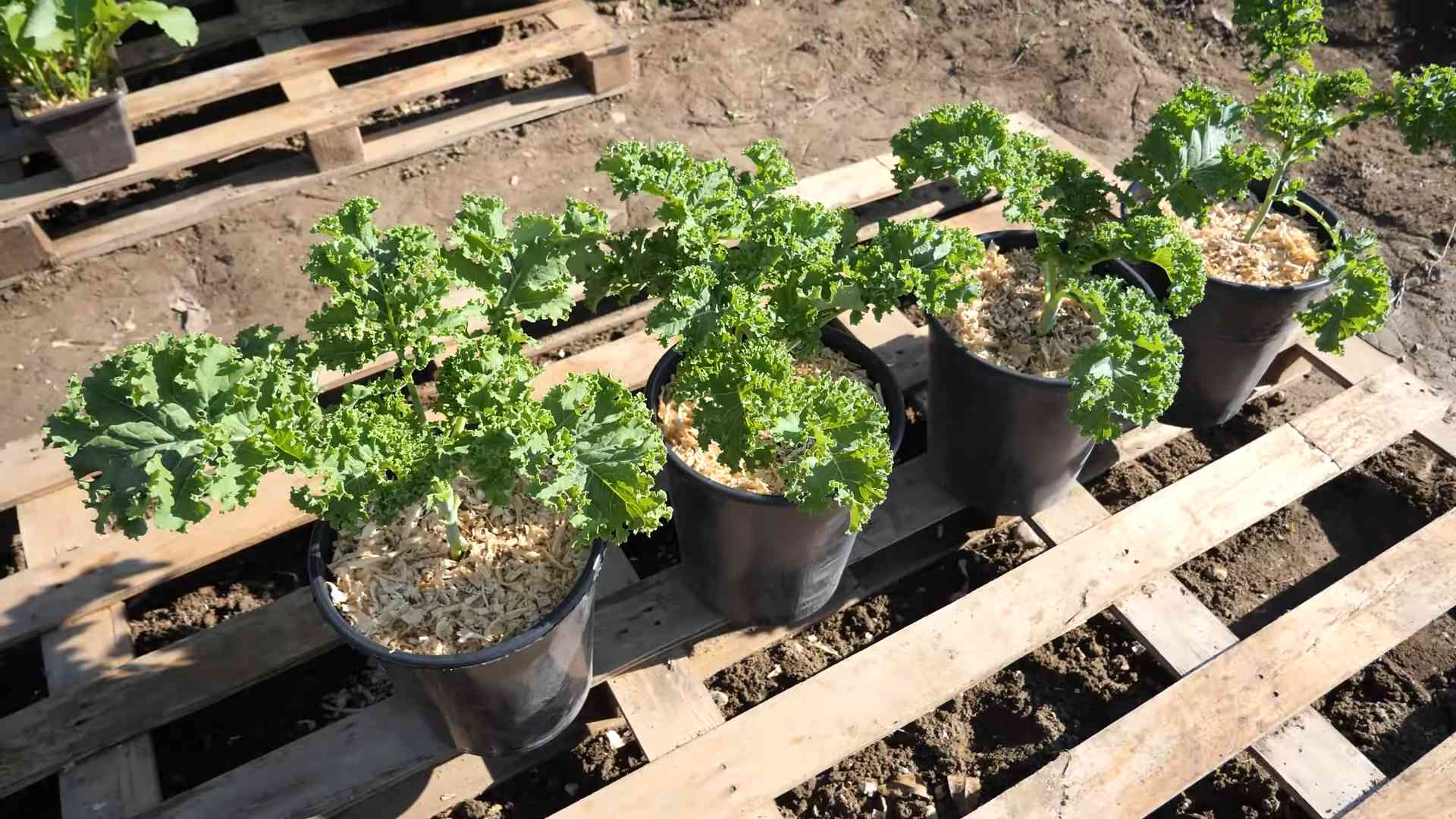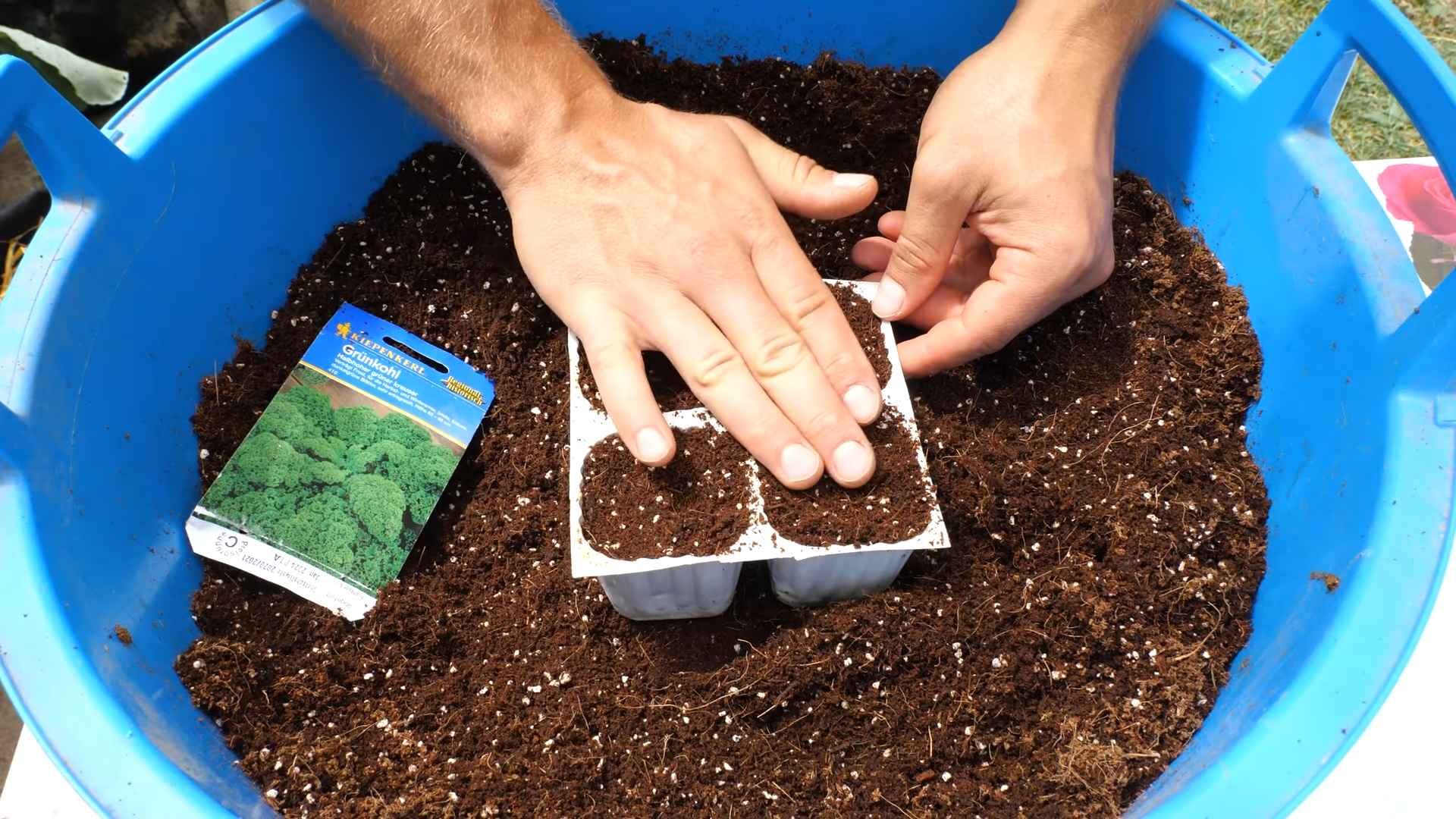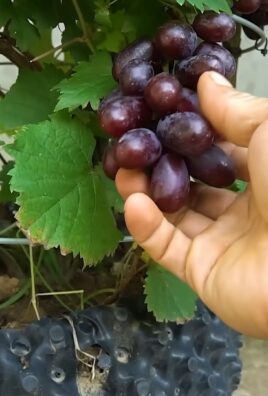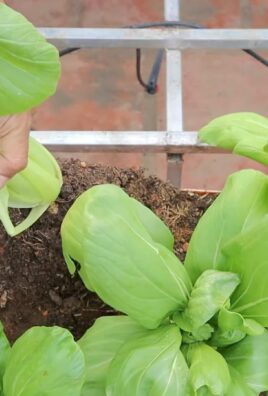Growing Kale at Home can seem daunting, but trust me, it’s easier than you think! Have you ever dreamed of stepping outside your back door and harvesting fresh, vibrant kale for a healthy salad or smoothie? I know I have, and let me tell you, the satisfaction is incredible. This DIY guide is packed with simple tricks and hacks that will transform your garden (or even your balcony!) into a kale-producing powerhouse.
Kale, a nutritional powerhouse, has a rich history, dating back to ancient Greece and Rome. It was a staple food for centuries, prized for its hardiness and health benefits. While it might have faded into the background for a while, kale has made a massive comeback in recent years, and for good reason! It’s packed with vitamins, minerals, and antioxidants, making it a superfood worth incorporating into your diet.
But why bother growing your own? Well, store-bought kale can be expensive and sometimes lacks the freshness and flavor of homegrown varieties. Plus, growing kale at home allows you to control exactly what goes into your food, avoiding harmful pesticides and ensuring the highest quality produce. In this article, I’ll share my favorite DIY tricks for successful kale cultivation, from seed to harvest. Get ready to enjoy delicious, homegrown kale all season long!

Growing Kale at Home: A Beginner’s Guide
Hey there, fellow garden enthusiasts! I’m so excited to share my experience with growing kale at home. It’s surprisingly easy, incredibly rewarding, and gives you access to fresh, nutritious greens right in your backyard (or even on your balcony!). This guide will walk you through everything you need to know, from choosing the right variety to harvesting your bounty. Let’s get started!
Choosing Your Kale Variety
Before you even think about planting, you need to decide what kind of kale you want to grow. There are tons of options, each with its own unique flavor and texture. Here are a few of my favorites:
* **Curly Kale (e.g., ‘Dwarf Blue Curled Vates’):** This is the classic kale you probably see in the grocery store. It has tightly curled leaves and a slightly bitter flavor that mellows out when cooked. It’s super hardy and easy to grow.
* **Lacinato Kale (aka Dinosaur Kale or Tuscan Kale):** This variety has long, narrow, dark green leaves with a slightly bumpy texture. It has a milder, sweeter flavor than curly kale and holds up well in soups and stews. I personally love this one!
* **Red Russian Kale:** This kale has flat, fringed leaves with purple stems. It’s incredibly beautiful and has a slightly sweet and peppery flavor. It’s also very cold-hardy.
* **Redbor Kale:** If you want to add a pop of color to your garden, Redbor kale is the way to go. It has deeply ruffled, purple leaves that get even more vibrant in cooler weather. It has a slightly milder flavor than other kales.
Starting from Seed vs. Buying Transplants
You have two main options for getting your kale plants: starting from seed or buying transplants from a nursery. Both have their pros and cons:
* **Starting from Seed:** This is the more economical option, and it gives you a wider selection of varieties to choose from. However, it requires a bit more time and effort. You’ll need to start your seeds indoors about 6-8 weeks before the last expected frost.
* **Buying Transplants:** This is the easier option, especially if you’re a beginner. You can simply buy healthy-looking plants from a local nursery and transplant them directly into your garden. However, you’ll have a more limited selection of varieties.
I’ve done both, and honestly, I prefer starting from seed. It’s just so satisfying to watch those tiny seeds sprout and grow into healthy plants!
Preparing Your Garden Bed
Kale needs well-drained soil that’s rich in organic matter. Here’s how to prepare your garden bed:
1. **Choose a Sunny Location:** Kale needs at least 6 hours of sunlight per day.
2. **Test Your Soil:** A soil test will tell you the pH and nutrient levels of your soil. Kale prefers a slightly acidic soil with a pH between 6.0 and 7.0.
3. **Amend Your Soil:** If your soil is heavy clay or sandy, amend it with compost or other organic matter to improve drainage and fertility. I usually add a generous layer of compost to my garden bed before planting.
4. **Till or Dig the Soil:** Loosen the soil to a depth of at least 12 inches. This will allow the roots to grow easily.
5. **Remove Rocks and Debris:** Get rid of any rocks, weeds, or other debris that could interfere with plant growth.
6. **Level the Soil:** Rake the soil to create a smooth, even surface.
Planting Your Kale
Now for the fun part – planting!
Planting Seeds Indoors (if starting from seed):
1. **Gather Your Supplies:** You’ll need seed starting trays or pots, seed starting mix, kale seeds, and a spray bottle.
2. **Fill the Trays/Pots:** Fill the trays or pots with seed starting mix.
3. **Sow the Seeds:** Sow the seeds about 1/4 inch deep. I usually plant 2-3 seeds per cell or pot to increase the chances of germination.
4. **Water Gently:** Water the seeds gently with a spray bottle.
5. **Provide Light:** Place the trays or pots under grow lights or in a sunny window.
6. **Keep the Soil Moist:** Keep the soil consistently moist, but not soggy.
7. **Thin the Seedlings:** Once the seedlings have their first true leaves (the second set of leaves), thin them to one plant per cell or pot. Choose the strongest, healthiest-looking seedling.
Transplanting Seedlings or Buying Transplants:
1. **Harden Off Seedlings (if starting from seed):** Before transplanting your seedlings outdoors, you need to harden them off. This means gradually exposing them to outdoor conditions over a period of 7-10 days. Start by placing them in a sheltered spot for a few hours each day, gradually increasing the amount of time they spend outdoors.
2. **Dig Holes:** Dig holes that are slightly larger than the root balls of your seedlings or transplants. Space the holes about 12-18 inches apart.
3. **Remove Plants from Containers:** Gently remove the plants from their containers. If the roots are pot-bound (tightly circling the pot), gently loosen them before planting.
4. **Place Plants in Holes:** Place the plants in the holes, making sure the top of the root ball is level with the soil surface.
5. **Fill Holes with Soil:** Fill the holes with soil and gently firm the soil around the plants.
6. **Water Thoroughly:** Water the plants thoroughly after planting.
Caring for Your Kale
Once your kale is planted, it’s important to provide it with the care it needs to thrive.
1. **Water Regularly:** Kale needs consistent moisture, especially during hot, dry weather. Water deeply whenever the top inch of soil feels dry.
2. **Fertilize:** Fertilize your kale every 4-6 weeks with a balanced organic fertilizer. I like to use fish emulsion or compost tea.
3. **Weed Regularly:** Keep your garden bed free of weeds, which can compete with your kale for nutrients and water.
4. **Mulch:** Apply a layer of mulch around your kale plants to help retain moisture, suppress weeds, and regulate soil temperature. I use straw or shredded leaves.
5. **Pest Control:** Keep an eye out for pests like aphids, cabbage worms, and flea beetles. You can control these pests with organic methods like insecticidal soap, neem oil, or hand-picking. I’ve found that covering my kale with row covers can also help prevent pest infestations.
6. **Protect from Frost:** Kale is relatively cold-hardy, but it can be damaged by severe frost. If you live in an area with harsh winters, you can protect your kale by covering it with a frost blanket or moving it to a sheltered location.
Harvesting Your Kale
You can start harvesting kale leaves as soon as they are large enough to eat, usually about 6-8 inches long.
1. **Harvest Outer Leaves:** Harvest the outer leaves first, leaving the inner leaves to continue growing. This is called “cut-and-come-again” harvesting.
2. **Use a Sharp Knife or Scissors:** Use a sharp knife or scissors to cut the leaves off at the base of the stem.
3. **Wash and Store:** Wash the harvested leaves thoroughly and store them in the refrigerator in a plastic bag or container. They will keep for several days.
Troubleshooting
Even with the best care, you might encounter some problems while growing kale. Here are a few common issues and how to address them:
* **Yellowing Leaves:** This could be a sign of nutrient deficiency, overwatering, or underwatering. Check your soil moisture and nutrient levels and adjust accordingly.
* **Holes in Leaves:** This is usually caused by pests like cabbage worms or flea beetles. Inspect your plants regularly and take action to control pests as needed.
* **Stunted Growth:** This could be caused by poor soil, lack of sunlight, or pest infestations. Make sure your kale is planted in well-drained, fertile soil and gets at least 6 hours of sunlight per day.
Enjoying Your Harvest
Now that you’ve harvested your kale, it’s time to enjoy it! Kale is incredibly versatile and can be used in a variety of dishes. Here are a few of my favorite ways to eat kale:
* **Kale Salad:** Massage kale leaves with olive oil, lemon juice, and salt until they are tender. Add your favorite toppings, such as nuts, seeds, dried fruit, and cheese.
* **Kale Chips:** Toss kale leaves with olive oil and salt and bake them in the oven until they are crispy.
* **Kale Smoothies:** Add kale to your favorite smoothie recipe for a boost of nutrients.
* **Kale Soup:** Add kale to soups and stews for added flavor and nutrition.
* **Sautéed Kale:** Sauté kale with garlic and olive oil for a simple and delicious side dish.
Growing kale

Conclusion
So, there you have it! Growing kale at home isn’t just a trendy gardening fad; it’s a genuinely rewarding experience that puts fresh, nutritious greens right at your fingertips. We’ve walked through the essential steps, from selecting the right kale variety to troubleshooting common problems, and hopefully, you’re feeling confident and ready to embark on your own kale-growing adventure.
Why is this DIY trick a must-try? Because store-bought kale, while convenient, simply can’t compare to the vibrant flavor and nutritional punch of homegrown kale. Think about it: you control the growing conditions, ensuring your kale is free from harmful pesticides and packed with vitamins. Plus, the satisfaction of harvesting your own food is unparalleled. It’s a connection to nature, a step towards self-sufficiency, and a delicious way to boost your health.
But the beauty of growing kale at home lies in its adaptability. Don’t be afraid to experiment! Try different varieties of kale – Lacinato (dinosaur kale) for its unique texture, Red Russian for its beautiful color and slightly sweeter taste, or Curly kale for its classic, robust flavor. Consider companion planting to deter pests and improve soil health. Marigolds, for example, are excellent at repelling nematodes, while aromatic herbs like rosemary and sage can confuse insect pests.
And the variations don’t stop there. You can grow kale in raised beds, containers, or even directly in the ground, making it accessible to gardeners of all skill levels and with varying amounts of space. If you live in a colder climate, consider using a cold frame or row covers to extend your growing season and enjoy fresh kale even during the winter months. You can even grow kale indoors under grow lights, ensuring a year-round supply of this superfood.
The key takeaway is to embrace the process and learn as you go. Don’t be discouraged by initial setbacks; gardening is a journey of continuous learning and adaptation. Every mistake is an opportunity to improve your techniques and deepen your understanding of the natural world.
We wholeheartedly encourage you to give growing kale at home a try. It’s an investment in your health, your well-being, and your connection to the environment. And once you’ve tasted the difference between store-bought and homegrown kale, you’ll never look back.
So, grab your seeds, prepare your soil, and get ready to experience the joy of harvesting your own delicious, nutritious kale. And most importantly, we want to hear about your experiences! Share your tips, successes, and challenges in the comments below. Let’s create a community of kale-loving gardeners who support and inspire each other. Happy growing!
Frequently Asked Questions (FAQs)
What is the best time of year to plant kale?
The best time to plant kale depends on your climate. In general, kale is a cool-season crop, meaning it thrives in temperatures between 60°F and 70°F (15°C and 21°C). For a spring harvest, start seeds indoors 6-8 weeks before the last expected frost or direct sow outdoors 2-4 weeks before the last frost. For a fall/winter harvest, sow seeds in mid-to-late summer. Kale can tolerate light frosts and even snow, which can actually improve its flavor. In warmer climates, you can grow kale throughout the winter.
What kind of soil does kale need?
Kale prefers well-drained soil that is rich in organic matter. A slightly acidic to neutral pH of 6.0 to 7.5 is ideal. Before planting, amend your soil with compost or well-rotted manure to improve its fertility and drainage. If your soil is heavy clay, consider adding sand or perlite to improve drainage. A soil test can help you determine the pH and nutrient levels of your soil and guide you in making necessary amendments.
How much sunlight does kale need?
Kale needs at least 6 hours of sunlight per day to thrive. However, it can tolerate partial shade, especially in hotter climates. If you’re growing kale indoors, use grow lights to provide adequate light. Insufficient sunlight can result in leggy plants with poor leaf development.
How often should I water kale?
Water kale regularly, especially during dry periods. Aim to keep the soil consistently moist but not waterlogged. Overwatering can lead to root rot. A good rule of thumb is to water deeply when the top inch of soil feels dry to the touch. Mulching around your kale plants can help retain moisture and suppress weeds.
What are some common pests and diseases that affect kale?
Common pests that affect kale include aphids, cabbage worms, flea beetles, and whiteflies. Diseases include black rot, clubroot, and downy mildew. Regularly inspect your plants for signs of pests or diseases. You can control pests with insecticidal soap, neem oil, or by handpicking them off the plants. To prevent diseases, ensure good air circulation, avoid overwatering, and practice crop rotation. Consider using row covers to protect your plants from pests.
How do I harvest kale?
You can begin harvesting kale leaves when they are about 4-6 inches long. Harvest the outer leaves first, leaving the inner leaves to continue growing. This cut-and-come-again method allows you to harvest kale continuously throughout the growing season. Avoid harvesting more than one-third of the plant at a time to ensure it continues to produce.
Can I eat kale stems?
Yes, you can eat kale stems, but they can be tough and fibrous. To make them more palatable, remove the leaves and chop the stems into small pieces. You can then sauté, steam, or roast them. Massaging kale leaves also helps to tenderize them.
How do I store kale after harvesting?
To store kale, wash it thoroughly and pat it dry. Wrap the kale in a paper towel and store it in a plastic bag in the refrigerator. Kale can last for up to a week when stored properly. You can also freeze kale for longer storage. To freeze kale, blanch it in boiling water for 2-3 minutes, then plunge it into ice water. Drain the kale and squeeze out any excess water. Store the kale in freezer bags or containers.
Is kale a good source of nutrients?
Yes, kale is an excellent source of nutrients. It is rich in vitamins A, C, and K, as well as calcium, potassium, and fiber. Kale is also a good source of antioxidants, which can help protect your body against damage from free radicals. Incorporating kale into your diet can contribute to overall health and well-being.
Can I grow kale in containers?
Absolutely! Growing kale in containers is a great option, especially if you have limited space. Choose a container that is at least 12 inches deep and wide. Use a well-draining potting mix and ensure the container has drainage holes. Water regularly and fertilize every few weeks. Container-grown kale may need more frequent watering than kale grown in the ground.
What are some creative ways to use homegrown kale?
The possibilities are endless! You can add kale to smoothies, salads, soups, stews, and stir-fries. You can also bake kale chips, sauté it with garlic and olive oil, or use it as a topping for pizza or pasta. Get creative and experiment with different recipes to find your favorite ways to enjoy your homegrown kale. Remember that growing kale at home is a journey of discovery, so don’t be afraid to try new things!





Leave a Comment